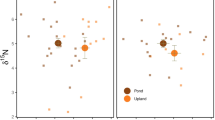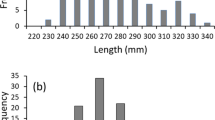Abstract
Nineteen species of Diptera (16 in each zone) from seven families were found in monthly collections (June 1979 through May 1980) in two Mississippi marsh plant zones dominated byJuncus roemerianus Scheele andSpartina cynosuroides (L.) Roth, respectively. TheJuncus zone was dominated by a species ofPalpomyia-Bezzia complex, two species ofBezzia (Ceratopogonidae),Paratendipes sp.,Limnophyes sp. (Chironomidae) andThinophilus frontalis (Dolichopodidae).Palpomyia-Bezzia sp.,Culicoides hollensis, Ormosia sp. (Tipulidae) andPelastoneurus abbreviatus (Dolichopodidae) dominated theSpartina zone. Total inset density and species richness were lowest in June and July in both zones, corresponding to a pulse of adult emergence. Overall, total density was significantly higher in theSpartina zone with mean values of 165 and 245 insects m−2 for the {Juncus} and {Spartina} zones, respectively. In addition to total density, differences in abundance were apparent for a number of species between marsh zones. Patterns could be attributed to species-specific habitat preference., predation by aquatic predators, and/or by interactions of the infauna themselves.
Similar content being viewed by others
Literature Cited
Alexander, C. P. 1942. Guide to the insects of Connecticut. Part VI. The Diptera or true flies of Connecticut. First fascicle. Family Tipulidae.Bull. Conn. State Geol. Nat. Hist. Surv. 64:196–486. (reprinted 1966).
Alexander, C. P., and G. W. Byers. 1981. Tipulidae, p. 153–190.In J. F. McAlpine, B. V. Peterson, G. E. Shewell, H. J. Teskey J. R., Vockeroth, and D. M. Wood (eds.), Manual of Nearctic Diptera, Vol. I. Res. Branch Agr. Can. Monogr. No. 27, Quebec. 674 p.
Ambrose, W. G., Jr. 1984. Role of predatory infauna in structuring marine soft-bottom communities.Mar. Ecol. Prog. Ser. 17:109–115.
Barnby, M. A., J. N. Collins, andV. H. Resh. 1985. Aquatic macroinvertebrate communities of natural and ditched potholes in a San Francisco Bay salt marsh.Estuarine Coastal Shelf Sci. 20:331–347.
Bell, S.S. 1980. Meiofauna-macrofauna interactions in a high salt marsh habitat.Ecol. Monogr. 50:487–505.
Bell, S. S., andB. C. Coull. 1978. Field evidence that shrimp predation regulates meiofauna.Oecologia 35:141–148.
Bell, S. S., M. C. Watzin, andB. C. Coull. 1978. Biogenic structure and its effect on the spatial heterogeneity of meiofauna in a salt marsh.J. Exp. Mar. Biol. Ecol. 35:99–107.
Berger, W. H., andF. L. Parker. 1970. Diversity of planktonic foraminifera in deep-sea sediments.Science 168:1345–1347.
Bickley, W. E., and T. R. Seek. 1975. Insects in four Maryland marshes. Univ. Maryland Agric. Exp. Sta. Misc. Publ. 870.
Bishop, T. D., andC. T. Hackney. 1987. A comparative study of the mollusc communities of two oligohaline intertidal marshes: Spatial and temporal distribution of their abundance and biomass.Estuaries 10(2):141–152.
Bloom, S. A. 1981. Similarity indices in community studies: Potential pitfalls.Mar. Ecol. Prog. Ser. 5:125–128.
Bray, J. R., andC. T. Curtis. 1957. An ordination of the upland forest communities of southern Wisconsin.Ecol. Monogr. 27:325–349.
Bromley, J. E. C., andS. Bleakney. 1979. Taxonomic survey of benthic fauna in estuarine saltmarsh pools, Minas Basin, Bay of Fundy.Proc. N. S. Inst. Sci. 29:411–446.
Cammen, L. M. 1976a. Abundance and production of macroinvertebrates from natural and artificially established salt marshes in North Carolina.Am. Midl. Nat. 96:487–493.
Cammen, L. M. 1976b. Macroinvertebrate colonization ofSpartina marshes artificially established on dredge spoil.Estuarine Coastal mar. Sci. 4:357–372.
Campbell, B. C., andR. F. Denno. 1978. The structure of the aquatic insect community associated with intertidal pools on a New Jersey salt marsh.Ecol. Entomol. 3:181–187.
Chan, K., andE. J. LeRoux. 1967. Ecological studies on three pond midges (Diptera: Ceratopogonidae) in Quebec.Ann. Entomol. Soc. Que. 12:14–68.
Cheng, L. 1976. Insects in the marine environment, p. 1–4.In L. Cheng (ed.), Marine Insects. Elsevier Publ. Co., New York.
Commito, J. A. 1982. Importance of predation by infaunal polychaetes in controlling the structure of a soft-bottom community in Maine, USA.Mar. Biol. 68:77–81.
Coull, B. C., S. S. Bell, A. M. Savory, andB. W. Dudley. 1979. Zonation of meiobenthic copepods in a southeastern United States salt marsh.Estuarine Coastal Mar. Sci. 9:181–188.
Davis, E. L., D. L. Kline, J. F. Reinert, R. H. Roberts, andJ. F. Butler. 1983. Development of immatureCulicoides mississippiensis (Diptera: Ceratopogonidae) in the laboratory.Ann. Entomol. Soc. Am. 76:918–924.
Davis, L. V., andH. E. Gray. 1966. Zonal and seasonal distribution of insects in North Carolina salt marshes.Ecol. Monogr. 36:275–295.
Dias, R. K., J. V. Merriner, and M. Hedgepeth. 1978. Part III. Aquatic biology—nekton, p. 55–78.In Habitat Development Field Investigation, Windmill Point Marsh Development Site, James River, Virginia; Appendix D.U.S. Army Eng. Waterways Exp. Sta. Tech. Rep. D-77-23.
Diaz, R. J., D. F. Boesch, J. L. Haver, C. A. Stone, and K. Munson. 1978. Part II: Aquatic biology—benthos, p. 18–54.In Habitat Development Field Investigation, Windmill Point Marsh Development Site, James River, Virginia; Appendix D.U.S. Army Eng. Waterways Exp. Sta. Tech. Rep. D-77-23.
Dove, W. E., andD. G. Hall. 1932. The salt marsh sand fly problem (Culicoides).Ann. Entomol. Soc. Am. 25:505–527.
Duobinis-Gray, E. M., andC. T. Hackney. 1982. Seasonal and spatial distribution of the Carolina marsh clamPolymesoda caroliniana (Bosc) in a Mississippi tidal marsh.Estuaries 5:102–109.
Dukes, J. C., T. D. Edwards, andR. C. Axtell. 1974a. Distribution of larval Tabanidae (Diptera) in aSpartina alterniflora salt marsh.J. Med. Entomol. 11:79–83.
Dukes, J. C., T. D. Edwards, andR. C. Axtell. 1974b. Associations of Tabanidae (Diptera) larvae with plant species in salt marshes, Carteret County, North Carolina.Environ. Entomol. 3:280–286.
Grogan, W. L., Jr., andW. W. Wirth. 1979. The North American predaceous midges of the genusPalpomyia Meigen (Diptera: Ceratopogonidae).Mem. Entomol. Soc. Wash. 8:1–125.
Hackney, C. T., andA. A. de la Cruz. 1978. Changes in interstitial water salinity of a Mississippi tidal marsh.Estuaries 1:185–188.
Harrington, R. W., Jr., andE. S. Harrington. 1961. Food selection among fishes invading a high subtropical salt marsh: From onset of flooding through the progress of a mosquito brood.Ecology 42:646–666.
Higley, D. L., andR. L. Holton. 1981. A study of the invertebrates and fishes of salt marshes in two Oregon estuaries. Misc. Rep. No. 81-5. U.S. Army Corps Eng., Coastal Eng. Res. Ctr., Fort Belvoir, Virginia. 132 p.
Holland, A. F. 1985. Long-term variation of macrobenthos in a mesohaline region of Chesapeake Bay.Estuaries 8:93–113.
Holland, A. F., N. K. Mountford, andJ. A. Mihursky. 1977. Temporal variation in upper bay mesohaline benthic communities: 1. The 9-m mud habitat.Chesapeake Sci. 18:370–378.
Holland, A. F., andT. T. Polgar. 1976. Seasonal changes in the structure of an intertidal community.Mar. Biol. 37:341–348.
Houlihan, D. F. 1969. The structure and behaviour ofNotiphila riparia andErioptera squalida, two root-piercing insects.J. Zool. 159:249–267.
Jamnback, H. 1965. TheCulicoides of New York State (Diptera: Ceratopogonidae).Bull. NY State Mus. 399:1–154.
Jamnback, H., W. Wall, andD. L. Collins. 1958. Control ofCulicoides melleus (Coq.) (Diptera: Heleidae) in small plots, with brief descriptions of the larvae of two coastalCulicoides.Mosq. News 18:64–70.
Khalaf, K. T. 1969. Distribution and phenology ofCulicoides (Diptera: Ceratopogonidae) along the Gulf of Mexico.Ann. Entomol. Soc. Am. 62:1153–1161.
Kline, D. L., andR. C. Axtell. 1976. Salt marshCulicoides (Diptera: Ceratopogonidae): Species, seasonal abundance and comparison of trapping methods.Mosq. News 36:1–10.
Kline, D. L., andR. C. Axtell. 1977. Distribution ofCulicoides hollensis, C. furens, andC. bermudensis in relation to plant cover in a North Carolina salt marsh (Diptera: Ceratopogonidae).J. Med. Entomol. 13:545–552.
Kneib, R. T. 1984. Patterns of invertebrate distribution and abundance in the intertidal salt marsh: Causes and questions.Estuaries 7:392–412.
Kneib, R. T., andA. E. Stiven. 1982. Benthic invertebrate responses to size and density manipulations of the common mummichog,Fundulus heteroclitus, in an intertidal salt marsh.Ecology 63:1518–1532.
Mahoney, B. M. S., andR. J. Livingston. 1982. Seasonal fluctuations of benthic macrofauna in the Apalachicola estuary, Florida, USA. The role of predation.Mar. Biol. 69: 207–213.
Maurer, D., W. Leathem, P. Kinner, andJ. Tinsman. 1979. Seasonal fluctuations in coastal benthic invertebrate assemblages.Estuarine Coastal Mar. Sci. 8:181–193.
May, R. M. 1975. Patterns of species abundance and diversity, p. 81–120.In M. L. Cody and J. M. Diamond, (eds.), Ecology and Evolution of Communities. Harvard Univ. Press, Cambridge. 545 p.
Osenga, G. A., andB. C. Coull. 1983.Spartina alterniflora Loisel root structure and meiofaunal abundance.J. Exp. Mar. Biol. Ecol. 67:221–225.
Rader, D. N. 1984. Salt-marsh benthic invertebrates: Small-scale patterns of distribution and abundance.Estuaries 7:413–420.
Reeder, W. G. 1951. Stomach analysis of a group of shorebirds.The Condor 53:43–45.
Rey, J. R., andE. D. McCoy. 1986. Terrestrial arthropods of northwest Florida salt marshes: Diptera (Insecta).Fla Entomol. 69:197–205.
Rockel, E. G., andE. J. Hansens. 1970a. Emergence and flight activity of salt-marsh horse flies and deer flies.Ann. Entomol. Soc. Am. 63:27–31.
Rockel, E. G., andE. J. Hansens. 1970b. Distribution of larval horse flies and deer flies (Diptera: Tabanidae) of a New Jersey salt marsh.Ann. Entomol. Soc. Am. 63:681–684.
Southwood, T. R. E. 1978. Ecological Methods with Particular Reference to the Study of Insect Populations, 2nd ed. Chapman and Hall, London. 524 p.
Stebbings, R. E. 1971. Some ecological observations on the fauna in a tidal marsh to woodland transition.Proc. Br. Entomol. Nat. Hist. Soc. 4:83–88.
Subrahmanyam, C. B., W. L. Kruczynski, andS. H. Drake. 1970. Studies on the animal communities in two north Florida salt marshes. Part II. Macroinvertebrate communities.Bull. Mar. Sci. 26:172–195.
Teal, J. M. 1958. Distribution of fiddler crabs in Georgia salt marshes.Ecology 39:185–193.
Teal, J. M., andW. Wieser. 1966. The distribution and ecology of nematodes in a Georgia salt marsh.Limnol. Oceanogr. 11:217–222.
Vince, S., I. Valiela, N. Backus, andJ. M. Teal. 1976. Predation by the salt marsh killifishFundulus heteroclitus (L.) in relation to prey size and habitat structure: Consequences for prey distribution and abundance.J. Exp. Mar. Biol. Ecol. 23:255–266.
Wall, W. J., Jr. 1973. The intertidal sand and salt marsh invertebrate fauna associated with the bloodsucking Diptera of Cape Cod, Massachusetts.Environ. Entomol. 2:681–684.
Wall, W. J., Jr., andO. W. Doane, Jr. 1960. A preliminary study of the bloodsucking Diptera on Cape Cod, Massachusetts.Mosq. News 20:39–44.
Ward, G., andG. J. FitzGerald. 1983. Macrobenthic abundance and distribution in tidal pools of a Quebec salt marsh.Can. J. Zool. 61:1071–1085.
Weiss, H. B., andE. West. 1924. The insects and plants of a salt marsh on the coastal plain of New Jersey.J. NY Entomol. Soc. 32:93–104.
Wirth, W. W., andA. Stone. 1956. Aquatic Diptera, p. 372–482.In R. L. Usinger (ed.), Aquatic Insects of California. Univ. Calif. Press, Berkeley, California. 508 p.
Wolf, E. G., B. Morson, andK. W. Fucik. 1983. Preliminary studies of food habits of juvenile fish in China Poot marsh and Potter marsh, Alaska, USA, 1978.Estuaries 6:102–114.
Zar, J. H. 1974. Biostatistical Analysis. Prentice-Hall, Englewood Cliffs, New Jersey. 620 p.
Author information
Authors and Affiliations
Rights and permissions
About this article
Cite this article
LaSalle, M.W., Dale Bishop, T. Seasonal abundance of aquatic diptera in two oligohaline tidal marshes in Mississippi. Estuaries 10, 303–315 (1987). https://doi.org/10.2307/1351888
Received:
Accepted:
Issue Date:
DOI: https://doi.org/10.2307/1351888




